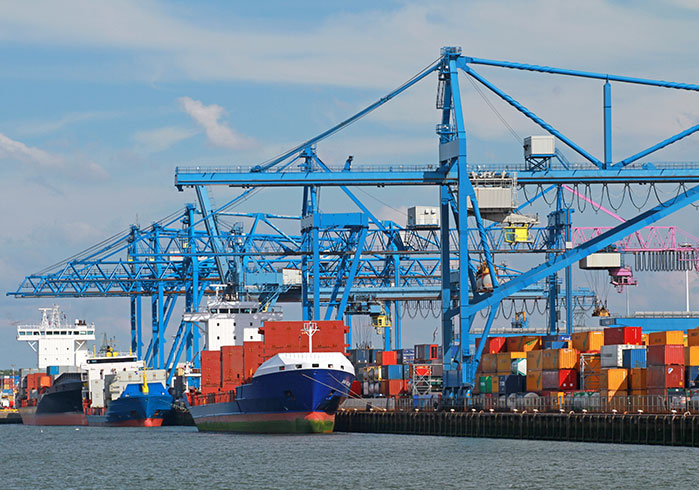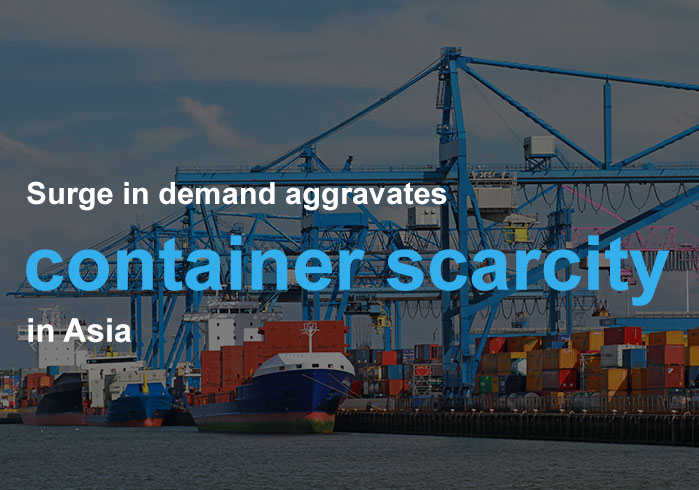
There is a growing shortage of container equipment in the Asian hubs of Shanghai, Singapore, and Port Kelang. This is on the back of a very strong peak season that has seen demand soaring beyond expectations. The box availability data from Container xChange (an online platform) has confirmed this trend.
Shanghai has a limited supply of TEU. The situation in Singapore is even more pressing with both TEU and FEU being in short supply. Information regarding this trend was extracted from the Container Availability Index (CAx) which serves both locations. Port Kelang in Malaysia is also showing a shortage of 20-foot container equipment. The message from the Container xChange could not be clearer.
In effect, the lower availability of containers across Asia has caused concern in the industry. The upcoming peak season means an increased need for containers in Asia. This has to be resolved to keep up with an increasing demand for cargo and goods shipped from the region.
Container Supply in Asia
There have been recent reports which have highlighted worsening container shortages in Asia. Part of the issue was that importers in the United States and Europe struggled to return empty containers to China and other Asian manufacturing hubs. The container imbalance was caused primarily by the spike in imports to the US and Europe during the critical months of July and August. This was after the reopening of the respective economies after lockdowns were put in place in the early days of the COVID-19 pandemic.
Container xChange expects the equipment shortage to tighten further as shippers race to get their cargo on the water before the Golden Week holidays. This is the time when China’s factories are expected to close, particularly in the period running from the 1st to the 7th of October. A recent update by US-based Worldwide Logistics Shanghai indicated that the container shortage was more widespread.
It is anticipated that this particular shortage will affect the vast majority of carriers that call at Shanghai, Shenzhen, Ningbo, Dalian, Tianjin, Qingdao, Xiamen, and Fuzhou. Apart from Cosco Shipping, most of the carriers were experiencing shortages in finding equipment. This was confirmed by an update released on the 9th of September.
In early September containers of all sizes (including the 20-foot, 40-foot, and 40-foot high-cube types) were in short supply. However, Container xChange indicated that the shortages were more acute among 20-foot boxes. Additionally, there was evidence that the 40-foot high-cubes were increasing in availability. This was particularly noticeable at port hubs such as Shanghai and Port Kelang.
The surge in Asia exports was also highlighted by Olivier Ghesquiere, president and CEO of container leasing company Textainer Group. During a mid-August call reporting on earnings, he indicated that the significant uptake in demand for containers has extended through the third quarter. According to him, the existing container inventory at Chinese factories held by lessors has by now been almost entirely committed. This would stand at about 600,000 TEU.
This change in market dynamics is driven by the cyclical increase in trade over the summer season. The regions that are most affected include North America and Europe. The trend is compounded by the restocking of inventories following the easing of quarantine measures in the most industrialized and wealthiest nations.
COVID-19-related disruptions in various supply chains have led to a dislocation of containers for shipping lines. The impact of these factors has been increased by the fact that for most of the past six quarters, shipping lines remained focused on cost optimization. This meant limiting their container fleet sizes.
How Rates Are Responding to Demand
One of the effects on the market has been high record-setting rates. This comes as US import demand soars. US imports grew strongly in August. Containerized imports from Asia increased by 13.4% from August 2019. Moreover, imports from mainland China were up 16.5%.
This trend has impacted the market in several different ways. For example, carriers have cut per diem times. This allows them to turn boxes quicker to get them back to Asia so that they can be loaded with the now priceless eastbound cargo. Many are moving towards a just-in-time approach to take advantage of any market opportunities.
We also know that the Asia-US West Coast rates hit a new record of $3,813 per FEU last week. This represents a 163.5% increase in the same week last year as reported by the Shanghai Containerized Freight Index (SCFI). Asia-US East Coast rates were generally up by 8% in the annual comparisons. They currently stand at $4,534 per FEU.
Similar trends are being reported in Europe. For example, the latest volume data (July) as reported by Container Trades Statistics (CTS) show a 1.9% increase in volume on Asia-Europe compared with the same month last year. Industry statistics indicate that there are 1.52 million TEU being moved on head haul routes.
Rising rate levels on Asia-Europe are consistent with forwarder reports indicating that volume remains strong. For example, SCFI average spot rate levels from Shanghai to North Europe last week stood at $1,054 per TEU. This represents a 56% increment when compared to a similar period in the previous year.
According to Dominique von Orelli (executive vice president and global head of ocean freight at DHL Global Forwarding), container equipment was currently deployed on the highest yielding trades. These were invariably the trans-Pacific and Asia-Latin America. It is therefore anticipated that there will be a shortage of equipment for the Asia-Europe trade. However, this assumption has been contradicted by some including Andreas Bütfering (senior director trade management and the Far East at Hapag-Lloyd) who perceived no particular shortage in container equipment on the Asia-Europe trade at the moment.
The contrary view from the expected rise in rates due to equipment shortages is based on the assumption that the extra capacity deployed in August is returning from Asia. Therefore, the trade should be much more balanced in the long run. This is regardless of the pressures on the equipment due to demand.
Wrapping Up
Given the surge in trade between Asia, Europe, and the USA; it is anticipated that there will be a shortage of equipment. Quite simply, the existing equipment will be put under a lot of pressure and that inevitably means an increase in rates. Suppliers and carriers must carefully study the market so that they can position their pricing and supply to meet demand, while at the same time taking full advantage of any opportunities that these trends are likely to bring. They certainly need all the help they can get, given the uncertainty that has been created by the COVID-19 pandemic.




